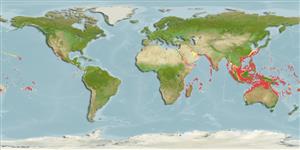分类 / Names
俗名 | 同种异名 | Catalog of Fishes(属, 种) | ITIS | CoL | WoRMS | Cloffa
Teleostei >
Dactylopteriformes (Flying gurnards) >
Pegasidae (Seamoths)
Etymology: Eurypegasus: Greek, eurys = long + Greek, Pegasus, pege = springs of Ocean near which Medusa was said to have been killed; the winged horse, sprung from the blood of Medusa (Ref. 45335); draconis: From the Latin word 'draco' meaning fabulous, lizard-like animal.
More on author: Linnaeus.
Environment: milieu / climate zone / depth range / distribution range
生态学
海洋; 半咸淡水 居于水底的; 深度上下限 3 - 91 m (Ref. 26165), usually 35 - 90 m (Ref. 33989). 熱帶; 32°N - 32°S
Indo-Pacific: Red Sea and South Africa (Ref. 4264) to Marquesan and Society Islands, north to southern Japan, south to Australia and Lord Howe Island; throughout Micronesia.
印度-太平洋: 對馬貴斯群島與社會群島的紅海與南非 (參考文獻 4264), 北至日本南部, 南至澳洲與羅得豪島; 在密克羅尼西亞各處。
大小 / 重量 / 年龄
Maturity: Lm ? range ? - ? cm
Max length : 10.0 cm TL 雄鱼/尚未辨别雌雄; (Ref. 3132)
背棘 (总数) : 0; 背的软条 (总数) : 5; 臀棘: 0; 臀鳍软条: 5; 脊椎骨: 19 - 22. Color in life variable; body usually light to dark brown, with dorsal and lateral area darker than ventral surface. Pectoral fins hyaline, distal margin white and spotted. Pelvic fin spine and 1st ray forming an elongate, tentacular structure. 3 pairs of dorsolateral body plates; 4 pairs of ventrolateral body plates; tail rings 8 (rarely 9), mobile. A pair of deep pits posterior to orbit. Suborbital shelf concave, eye visible in ventral view. Ventral ridges of rostrum greatly expanded than dorsal ridges, each with laterally directed denticles. Anal papilla absent.
颜色活着时可变的; 身体通常淡色到深褐色的, 有背部的与侧面的区域比腹面颜色更深。 胸鳍透明又末梢部的边缘白色与有斑点的。 腹鳍棘与第一鳍条形成细长又触丝的结构。 三对体背外侧的碟; 四对体腹外侧的碟; 尾环 8(很少地 9), 移动的。 一对深的洼凹在眼窝后面。 眶下架凹曲, 眼看得见的由腹面观之。 喙的腹面脊非常扩大了胜于背部的脊,每个具有朝向侧面的细齿。 肛门的乳突不存在。
Inhabit lagoons often among algal or seagrass beds (Ref. 5503). Found on sand or silt bottoms, frequently in bays or estuaries (Ref. 3132). They are opportunistic feeders that collect mainly epifaunal and interstitial invertebrate prey, e.g., crustaceans and worms from the sediment-water interface (Ref. 31134). Shed their skin in one piece with a rapid jump periodically to rid themselves of accumulated ballast (Ref. 31134). Adults usually in pairs on muddy substrates (Ref. 48635). Has a monogamous mating system with close-pair bonding (Ref. 90102).
栖息于泻湖常见于海藻或海草床之中.(参考文献 5503) 栖息于沙子或淤泥底了, 时常在海湾或河口.(参考文献 3132) 他们是主要采集表生种而间质的无脊椎动物猎物,例如 , 甲壳动物与蠕虫从沉淀物-水的介面的随机捕食者。 (参考文献 31134) 在一块中脱落他们的皮肤用一个周期性的快速跳跃积累的压载物免除他们自己。 (参考文献 31134) 在泥质底部上成鱼通常成对出现。 (参考文献 48635)
Life cycle and mating behavior
成熟度 | 繁殖 | 产卵场 | 卵 | 孕卵数 | 仔鱼
Are broadcast spawners. In several aquaria, spawning is observed as pairs rose to about 50 cm above the substrate, their ventral surfaces closely opposed, releasing gametes at the apex of their upward rush; then they glided down to the bottom. As the pairs landed on the substrate, the male continued to follow his mate. Release of gametes follows. Spawning occurred only within pairs (obligate and genetic monogamy) (Ref. 52884).印度-太平洋: 對馬貴斯群島與社會群島的紅海與南非 (參考文獻 4264), 北至日本南部, 南至澳洲與羅得豪島; 在密克羅尼西亞各處。
Palsson, W.A. and T.W. Pietsch, 1989. Revision of the Acanthopterygian fish Family Pegasidae (Order Gasterosteiformes). Indo-Pac. Fish. (18):38 p. (Ref. 1418)
世界自然保护联盟红皮书 (Ref. 130435: Version 2024-1)
人类利用
工具
特别资料
下载 XML
网络资源
Estimates based on models
Preferred temperature (Ref.
123201): 21.8 - 28.3, mean 26.7 °C (based on 757 cells).
Phylogenetic diversity index (Ref.
82804): PD
50 = 0.7656 [Uniqueness, from 0.5 = low to 2.0 = high].
Bayesian length-weight: a=0.01000 (0.00244 - 0.04107), b=3.04 (2.81 - 3.27), in cm total length, based on all LWR estimates for this body shape (Ref.
93245).
营养阶层 (Ref.
69278): 3.2 ±0.36 se; based on food items.
Fishing Vulnerability (Ref.
59153): Low vulnerability (10 of 100).
Nutrients (Ref.
124155): Calcium = 145 [80, 343] mg/100g; Iron = 1.25 [0.67, 2.19] mg/100g; Protein = 18.4 [17.1, 19.6] %; Omega3 = 0.218 [0.102, 0.474] g/100g; Selenium = 48.1 [20.1, 106.8] μg/100g; VitaminA = 61 [17, 206] μg/100g; Zinc = 2.95 [1.88, 4.31] mg/100g (wet weight);
